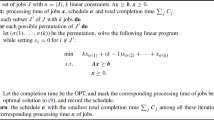Abstract
We consider a new and general online resource allocation problem, where the goal is to maximize a function of a positive semidefinite (PSD) matrix with a scalar budget constraint. The problem data arrives online, and the algorithm needs to make an irrevocable decision at each step. Of particular interest are classic experiment design problems in the online setting, with the algorithm deciding whether to allocate budget to each experiment as new experiments become available sequentially. We analyze two greedy primal-dual algorithms and provide bounds on their competitive ratios. Our analysis relies on a smooth surrogate of the objective function that needs to satisfy a new diminishing returns (PSD-DR) property (that its gradient is order-reversing with respect to the PSD cone). Using the representation for monotone maps on the PSD cone given by Löwner’s theorem, we obtain a convex parametrization of the family of functions satisfying PSD-DR. We then formulate a convex optimization problem to directly optimize our competitive ratio bound over this set. This design problem can be solved offline before the data start arriving. The online algorithm that uses the designed smoothing is tailored to the given cost function, and enjoys a competitive ratio at least as good as our optimized bound. We provide examples of computing the smooth surrogate for D-optimal and A-optimal experiment design, and demonstrate the performance of the custom-designed algorithm.





Similar content being viewed by others
Notes
To simplify the notation in the rest of the paper, assume \(H(0) = 0\) by replacing h(u) with \(h(u) - h(0)\).
Note that we could choose, for instance, \(u_{\max } = b'\max _{t} c_t^{-1}\lambda _{\max }(A_t)\), but for certain classes of problems better bounds may be available.
We can extend the domain of \(G_S\) to negative reals by letting \(G_S = 0\) on \(\mathbf {R}_{-}\) to satisfy the technical assumption on the domain of \(G_S\) in Assumption (2).
Note that we could choose, for instance, \(u_{\max } = b'\max _t c_t^{-1}\lambda _{\max }(A_t)\), but for certain classes of problems better bounds may be available.
References
Agrawal, S., Devanur, N.R.: Fast algorithms for online stochastic convex programming. In: Proceedings of the Twenty-Sixth Annual Symposium on Discrete Algorithms, pp. 1405–1424. SIAM (2015)
Agrawal, S., Wang, Z., Ye, Y.: A dynamic near-optimal algorithm for online linear programming. Oper. Res. 62(4), 876–890 (2014)
Azar, Y., Buchbinder, N., Chan, T.H., Chen, S., Cohen, I.R., Gupta, A., Huang, Z., Kang, N., Nagarajan, V., Naor, J., et al: Online algorithms for covering and packing problems with convex objectives. In: 2016 IEEE 57th Annual Symposium on Foundations of Computer Science (FOCS), pp. 148–157. IEEE (2016)
Bian, A.A., Buhmann, J.M., Krause, A., Tschiatschek, S.: Guarantees for greedy maximization of non-submodular functions with applications (2017). arXiv:1703.02100
Bouhtou, M., Gaubert, S., Sagnol, G.: Submodularity and randomized rounding techniques for optimal experimental design. Electron. Discret. Math. 36, 679–686 (2010)
Buchbinder, N., Naor, J.: Improved bounds for online routing and packing via a primal-dual approach. In: 47th Annual IEEE Symposium on Foundations of Computer Science (FOCS’06), pp. 293–304. IEEE (2006)
Buchbinder, N., Naor, J.: Online primal-dual algorithms for covering and packing. Math. Oper. Res. 34(2), 270–286 (2009)
Buchbinder, N., Naor, J.S.: The design of competitive online algorithms via a primal-dual approach Foundations and Trends®. Theor. Comput. Sci. 3(2–3), 93–263 (2009)
Buchbinder, N., Jain, K., Naor, J.S.: Online primal-dual algorithms for maximizing ad-auctions revenue. In: Algorithms–ESA 2007, pp. 253–264. Springer, Berlin (2007)
Devanur, N.R., Jain, K.: Online matching with concave returns. In: Proceedings of the forty-fourth annual ACM symposium on theory of computing (STOC), pp. 137–144. ACM (2012)
Dragomir, S.S.: Some Gronwall Type Inequalities and Applications. Nova Science, New York (2003)
Eghbali, R.: Online algorithm design via smoothing with application to online experiment selection. Ph.D. thesis, The University of Washington (2017)
Eghbali, R., Fazel, M.: Designing smoothing functions for improved worst-case competitive ratio in online optimization. In: Advances in Neural Information Processing Systems, pp. 3279–3287 (2016)
Eghbali, R., Fazel, M.: Worst case competitive analysis of online algorithms for conic optimization (2016). arXiv:1611.00507
Eghbali, R., Swenson, J., Fazel, M.: Exponentiated subgradient algorithm for online optimization under the random permutation model (2014). arXiv:1410.7171
Elad, N., Kale, S., Naor, J.S.: Online semidefinite programming. In: LIPIcs-Leibniz International Proceedings in Informatics, Schloss Dagstuhl-Leibniz-Zentrum fuer Informatik, vol. 55 (2016)
Gupta, A., Molinaro, M.: How the experts algorithm can help solve LPs online. Math. Oper. Res. 41(4), 1404–1431 (2016)
Hansen, F.: The fast track to Löwners theorem. Linear Algebra Appl. 438(11), 4557–4571 (2013)
Kapralov, M., Post, I., Vondrák, J.: Online submodular welfare maximization: greedy is optimal. In: Proceedings of the Twenty-Fourth Annual Symposium on Discrete Algorithms, pp. 1216–1225.SIAM (2013)
Legrain, A., Jaillet, P.: A stochastic algorithm for online bipartite resource allocation problems. Comput. Oper. Res. 75, 28–37 (2016)
Lewis, A.S.: The convex analysis of unitarily invariant matrix functions. J. Convex Anal. 2(1), 173–183 (1995)
Mehta, A., Saberi, A., Vazirani, U., Vazirani, V.: Adwords and generalized online matching. J. ACM 54(5), 22 (2007)
Meng, D., Fazel, M., Mesbahi, M.: Online algorithms for network formation. In: IEEE Conference on Decision and Control (CDC), pp. 135–140 (2016)
Molinaro, M., Ravi, R.: The geometry of online packing linear programs. Math. Oper. Res. 39(1), 46–59 (2013)
Pukelsheim, F.: Optimal Design of Experiments, vol. 50. SIAM, Philadelphia (1993)
Reiz, A.: On the numerical solution of certain types of integral equations. Medd. Fran Lunds Astrono. Obs. Ser. I 161, 1–21 (1943)
Rockafellar, R.T., Wets, R.J.B., Wets, M.: Variational Analysis, vol. 317. Springer, Berlin (1998)
Seeger, M.: On the submodularity of linear experimental design. Tech. rep., Saarland University (2009)
Shalev-Shwartz, S., Singer, Y.: A primal-dual perspective of online learning algorithms. Mach. Learn. 69(2–3), 115–142 (2007)
Shamaiah, M., Banerjee, S., Vikalo, H.: Greedy sensor selection: Leveraging submodularity. In: 49th IEEE Conference on Decision and Control (CDC), pp. 2572–2577. IEEE (2010)
Wang, Y., Yu, A.W., Singh, A.: On computationally tractable selection of experiments in regression models (2016). arXiv:1601.02068
Acknowledgements
The authors thank Omid Sadeghi-Meibodi for helpful comments. The work of MF and RE was supported in part by Grants ONR N000141612789, NSF CCF 1409836, NSF Tripods 1740551, and ONR MURI N000141612710. Part of this work was done while RE and MF were visiting the Simons Institute for the Theory of Computing, partially supported by the DIMACS/Simons Collaboration on Bridging Continuous and Discrete Optimization through NSF Grant CCF-1740425.
Author information
Authors and Affiliations
Corresponding author
A Additional proofs
A Additional proofs
Here, we provide additional proofs not given in detail in the body of the paper.
Proof
(of Lemma 1) By the definition of \(D_{\text {sim}}\), the definition of \(\tilde{x}_t\), and the concavity of \(H_S\) and \(G_S\), we have that
The inequality follows from concavity of \(G_S\) and \(H_S\). The final equality holds by telescoping the sum and using the fact that \(H_S(0) = 0 = G_S(0)\). For the sequential algorithm we can write:
Now, the rest follows similar to steps as the simultaneous case. \(\square \)
Proof
(of Lemma 2) We write out the argument for the inequality \(D_{\text {sim}} \ge D^\star \). The argument showing that \(D_{\text {seq}} \ge D^\star \) is identical. We first show that the PSD-DR assumption on \(H_S\) implies
Since \(A_s \in S_+^n\) and \(\tilde{x}_s \ge 0\) for all \(s\in [m]\), it follows that \(\sum _{s=1}^{t}A_s \tilde{x}_s \preceq \sum _{s=1}^{m}A_s\tilde{x}_s\) for all \(t\in [m]\). Since \(\tilde{Y}_t = \nabla H_S\left( \sum _{s=1}^{t}A_s\tilde{x}_s\right) \), if \(H_S\) satisfies the PSD-DR assumption then \(\tilde{Y}_t \succeq \tilde{Y}_m\) for all \(t\in [m]\). By a similar argument, since \(G_S\) is concave, \(\tilde{z}_t \ge \tilde{z}_m\) for all \(t\in [m]\). Since \(A_t \in S_+^n\) and \(c_t \ge 0\) for all \(t\in [m]\),
for all \(t\in [m]\). Taking the positive part and then summing establishes (28). To conclude that \(D_{\text {sim}}\ge D^\star \), we need only observe that \(D^\star \) is a lower bound on the dual objective (4) evaluated at \((\tilde{Y}_m,\tilde{z}_m)\). \(\square \)
Rights and permissions
About this article
Cite this article
Eghbali, R., Saunderson, J. & Fazel, M. Competitive online algorithms for resource allocation over the positive semidefinite cone. Math. Program. 170, 267–292 (2018). https://doi.org/10.1007/s10107-018-1305-1
Received:
Accepted:
Published:
Issue Date:
DOI: https://doi.org/10.1007/s10107-018-1305-1




